IFRS, Financial Capital, AASB 9: Financial Instrument Analysis Report
VerifiedAdded on 2019/10/30
|9
|1596
|165
Report
AI Summary
This report provides a detailed overview of financial capital maintenance and physical capital maintenance under the IFRS framework. It differentiates between the financial concept of capital, related to net assets and equity, and the physical concept, based on an entity's production capacity. The report then focuses on AASB 9, the new and revised standard for financial instruments, exploring its implications on classification, measurement, and recognition of financial assets and liabilities. It highlights the changes from AASB 139, including the categorization of financial assets into amortized cost and fair value, along with the flexibility in applying hedge accounting. The report includes an example illustrating the accounting implications of AASB 9, comparing the treatment under both current and the new standards. References from various academic sources are provided to support the analysis.

Assignment
Paraphrase This Document
Need a fresh take? Get an instant paraphrase of this document with our AI Paraphraser
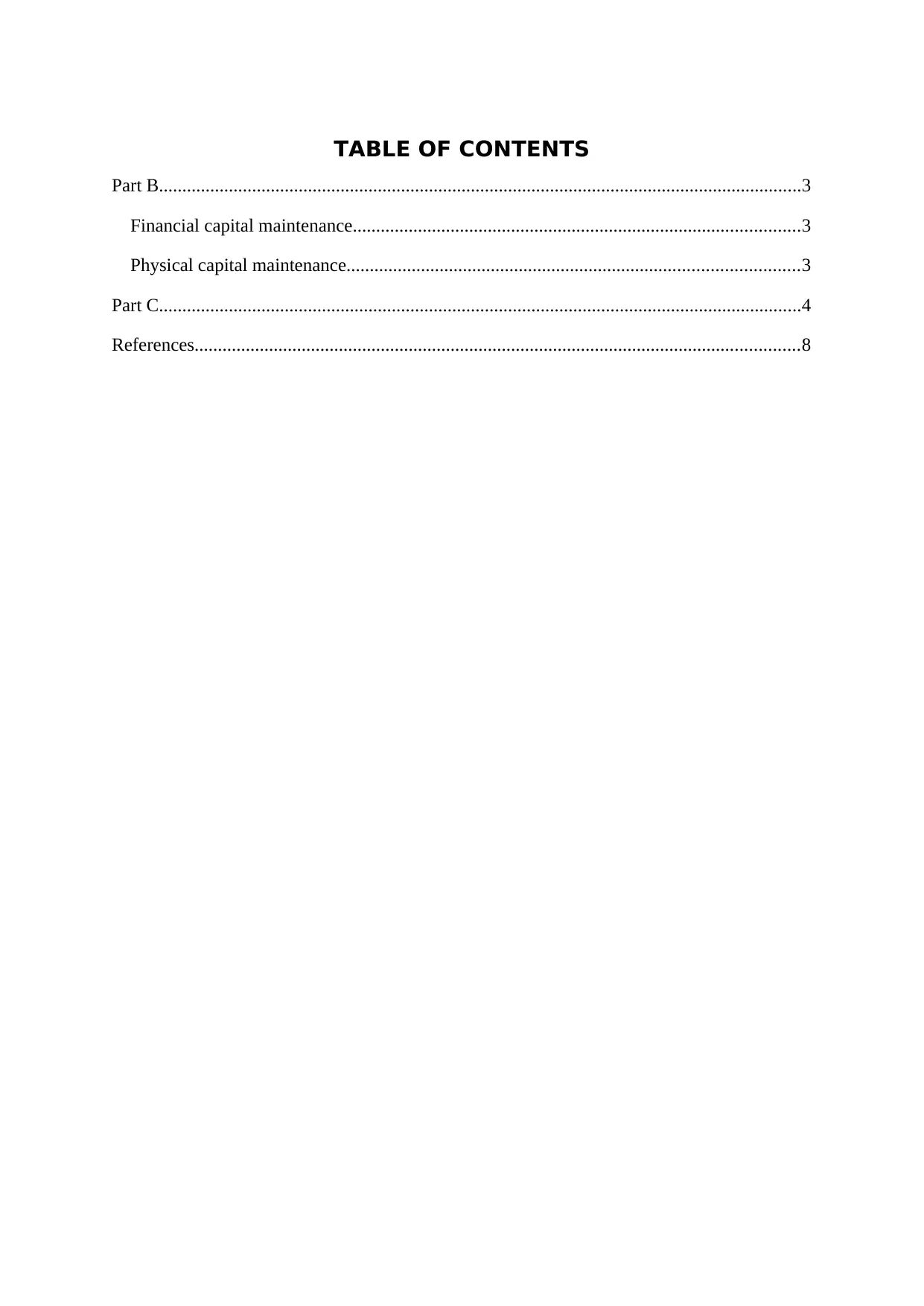
TABLE OF CONTENTS
Part B..........................................................................................................................................3
Financial capital maintenance................................................................................................3
Physical capital maintenance.................................................................................................3
Part C..........................................................................................................................................4
References..................................................................................................................................8
Part B..........................................................................................................................................3
Financial capital maintenance................................................................................................3
Physical capital maintenance.................................................................................................3
Part C..........................................................................................................................................4
References..................................................................................................................................8
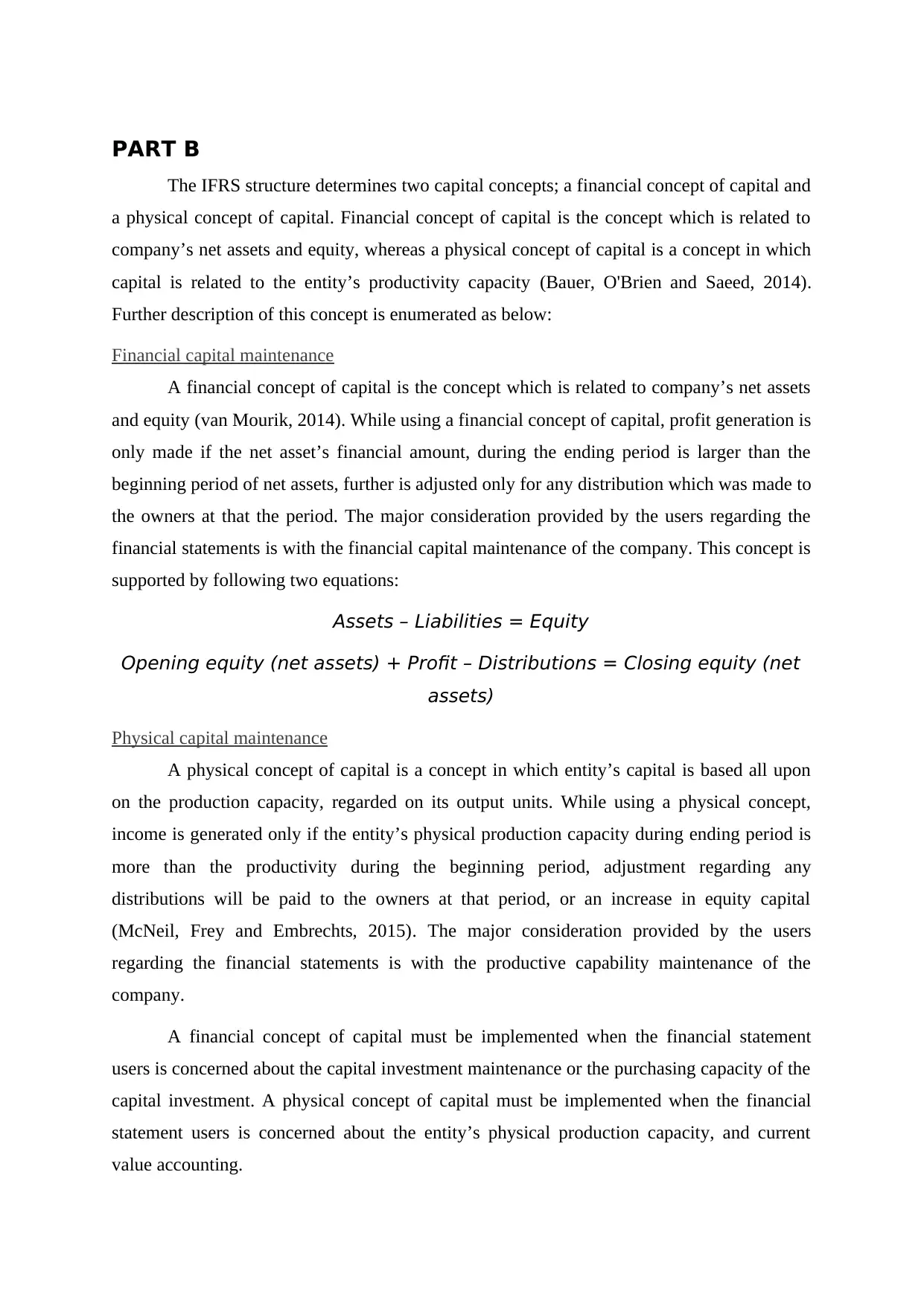
PART B
The IFRS structure determines two capital concepts; a financial concept of capital and
a physical concept of capital. Financial concept of capital is the concept which is related to
company’s net assets and equity, whereas a physical concept of capital is a concept in which
capital is related to the entity’s productivity capacity (Bauer, O'Brien and Saeed, 2014).
Further description of this concept is enumerated as below:
Financial capital maintenance
A financial concept of capital is the concept which is related to company’s net assets
and equity (van Mourik, 2014). While using a financial concept of capital, profit generation is
only made if the net asset’s financial amount, during the ending period is larger than the
beginning period of net assets, further is adjusted only for any distribution which was made to
the owners at that the period. The major consideration provided by the users regarding the
financial statements is with the financial capital maintenance of the company. This concept is
supported by following two equations:
Assets – Liabilities = Equity
Opening equity (net assets) + Profit – Distributions = Closing equity (net
assets)
Physical capital maintenance
A physical concept of capital is a concept in which entity’s capital is based all upon
on the production capacity, regarded on its output units. While using a physical concept,
income is generated only if the entity’s physical production capacity during ending period is
more than the productivity during the beginning period, adjustment regarding any
distributions will be paid to the owners at that period, or an increase in equity capital
(McNeil, Frey and Embrechts, 2015). The major consideration provided by the users
regarding the financial statements is with the productive capability maintenance of the
company.
A financial concept of capital must be implemented when the financial statement
users is concerned about the capital investment maintenance or the purchasing capacity of the
capital investment. A physical concept of capital must be implemented when the financial
statement users is concerned about the entity’s physical production capacity, and current
value accounting.
The IFRS structure determines two capital concepts; a financial concept of capital and
a physical concept of capital. Financial concept of capital is the concept which is related to
company’s net assets and equity, whereas a physical concept of capital is a concept in which
capital is related to the entity’s productivity capacity (Bauer, O'Brien and Saeed, 2014).
Further description of this concept is enumerated as below:
Financial capital maintenance
A financial concept of capital is the concept which is related to company’s net assets
and equity (van Mourik, 2014). While using a financial concept of capital, profit generation is
only made if the net asset’s financial amount, during the ending period is larger than the
beginning period of net assets, further is adjusted only for any distribution which was made to
the owners at that the period. The major consideration provided by the users regarding the
financial statements is with the financial capital maintenance of the company. This concept is
supported by following two equations:
Assets – Liabilities = Equity
Opening equity (net assets) + Profit – Distributions = Closing equity (net
assets)
Physical capital maintenance
A physical concept of capital is a concept in which entity’s capital is based all upon
on the production capacity, regarded on its output units. While using a physical concept,
income is generated only if the entity’s physical production capacity during ending period is
more than the productivity during the beginning period, adjustment regarding any
distributions will be paid to the owners at that period, or an increase in equity capital
(McNeil, Frey and Embrechts, 2015). The major consideration provided by the users
regarding the financial statements is with the productive capability maintenance of the
company.
A financial concept of capital must be implemented when the financial statement
users is concerned about the capital investment maintenance or the purchasing capacity of the
capital investment. A physical concept of capital must be implemented when the financial
statement users is concerned about the entity’s physical production capacity, and current
value accounting.
⊘ This is a preview!⊘
Do you want full access?
Subscribe today to unlock all pages.

Trusted by 1+ million students worldwide
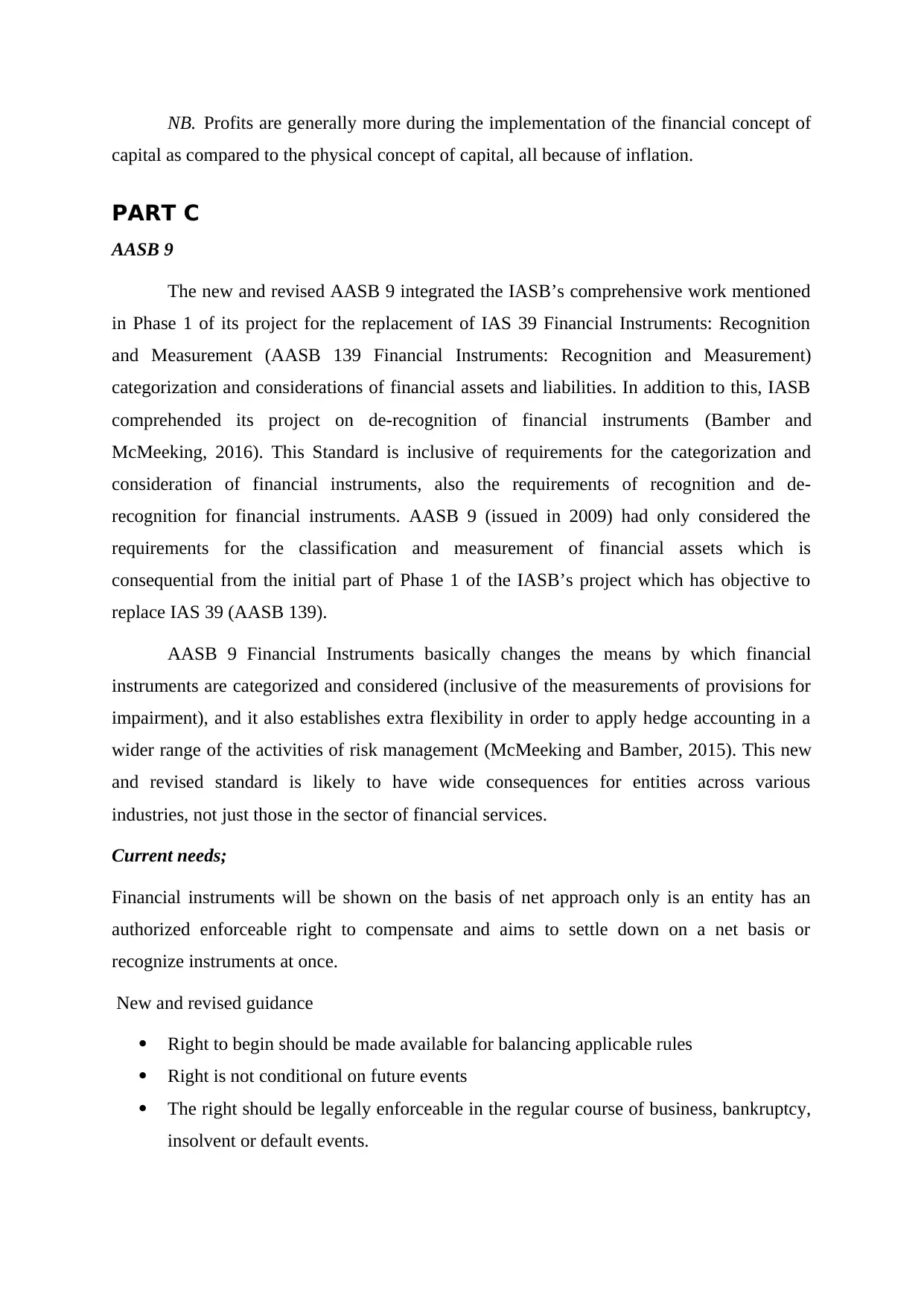
NB. Profits are generally more during the implementation of the financial concept of
capital as compared to the physical concept of capital, all because of inflation.
PART C
AASB 9
The new and revised AASB 9 integrated the IASB’s comprehensive work mentioned
in Phase 1 of its project for the replacement of IAS 39 Financial Instruments: Recognition
and Measurement (AASB 139 Financial Instruments: Recognition and Measurement)
categorization and considerations of financial assets and liabilities. In addition to this, IASB
comprehended its project on de-recognition of financial instruments (Bamber and
McMeeking, 2016). This Standard is inclusive of requirements for the categorization and
consideration of financial instruments, also the requirements of recognition and de-
recognition for financial instruments. AASB 9 (issued in 2009) had only considered the
requirements for the classification and measurement of financial assets which is
consequential from the initial part of Phase 1 of the IASB’s project which has objective to
replace IAS 39 (AASB 139).
AASB 9 Financial Instruments basically changes the means by which financial
instruments are categorized and considered (inclusive of the measurements of provisions for
impairment), and it also establishes extra flexibility in order to apply hedge accounting in a
wider range of the activities of risk management (McMeeking and Bamber, 2015). This new
and revised standard is likely to have wide consequences for entities across various
industries, not just those in the sector of financial services.
Current needs;
Financial instruments will be shown on the basis of net approach only is an entity has an
authorized enforceable right to compensate and aims to settle down on a net basis or
recognize instruments at once.
New and revised guidance
Right to begin should be made available for balancing applicable rules
Right is not conditional on future events
The right should be legally enforceable in the regular course of business, bankruptcy,
insolvent or default events.
capital as compared to the physical concept of capital, all because of inflation.
PART C
AASB 9
The new and revised AASB 9 integrated the IASB’s comprehensive work mentioned
in Phase 1 of its project for the replacement of IAS 39 Financial Instruments: Recognition
and Measurement (AASB 139 Financial Instruments: Recognition and Measurement)
categorization and considerations of financial assets and liabilities. In addition to this, IASB
comprehended its project on de-recognition of financial instruments (Bamber and
McMeeking, 2016). This Standard is inclusive of requirements for the categorization and
consideration of financial instruments, also the requirements of recognition and de-
recognition for financial instruments. AASB 9 (issued in 2009) had only considered the
requirements for the classification and measurement of financial assets which is
consequential from the initial part of Phase 1 of the IASB’s project which has objective to
replace IAS 39 (AASB 139).
AASB 9 Financial Instruments basically changes the means by which financial
instruments are categorized and considered (inclusive of the measurements of provisions for
impairment), and it also establishes extra flexibility in order to apply hedge accounting in a
wider range of the activities of risk management (McMeeking and Bamber, 2015). This new
and revised standard is likely to have wide consequences for entities across various
industries, not just those in the sector of financial services.
Current needs;
Financial instruments will be shown on the basis of net approach only is an entity has an
authorized enforceable right to compensate and aims to settle down on a net basis or
recognize instruments at once.
New and revised guidance
Right to begin should be made available for balancing applicable rules
Right is not conditional on future events
The right should be legally enforceable in the regular course of business, bankruptcy,
insolvent or default events.
Paraphrase This Document
Need a fresh take? Get an instant paraphrase of this document with our AI Paraphraser
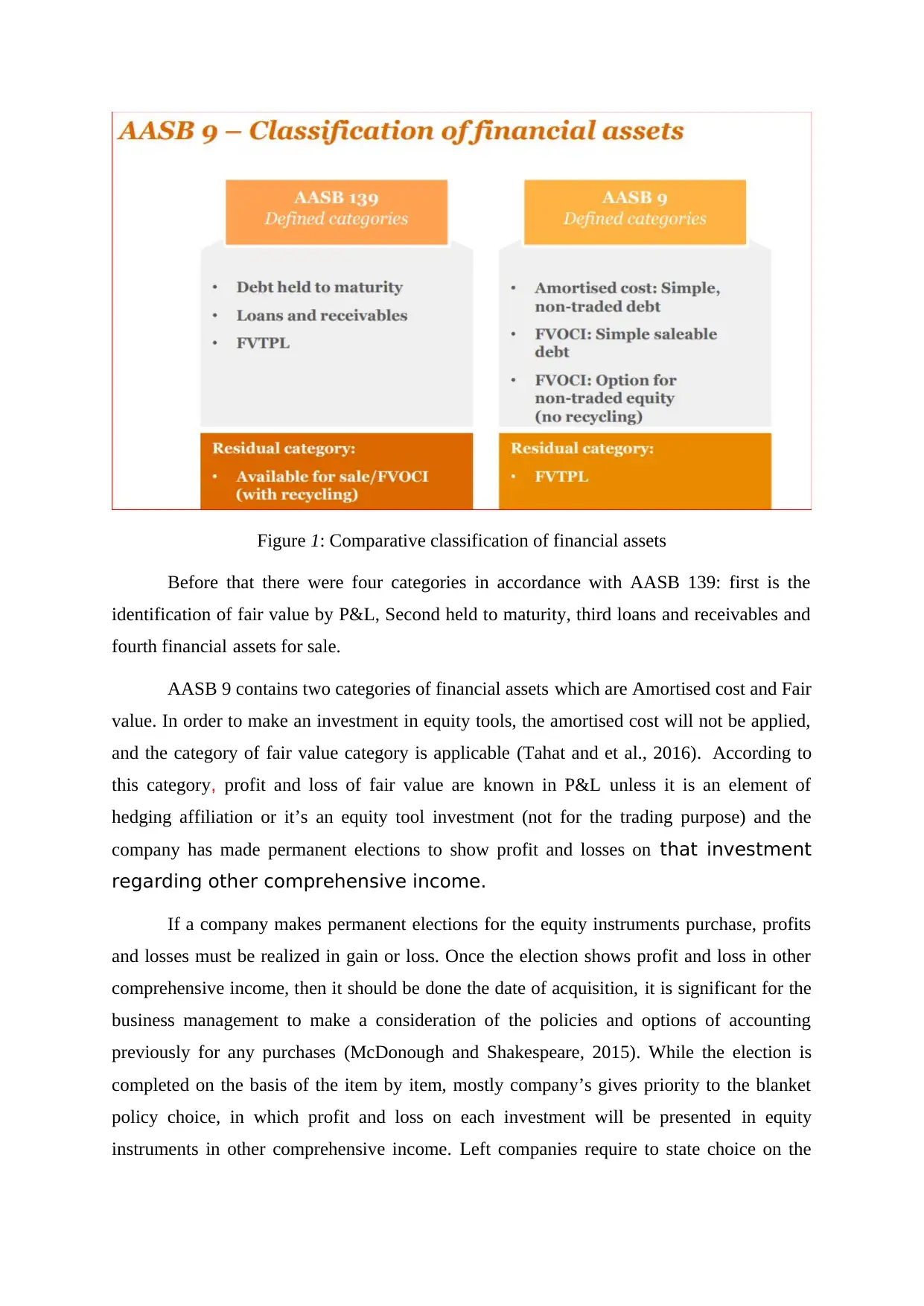
Figure 1: Comparative classification of financial assets
Before that there were four categories in accordance with AASB 139: first is the
identification of fair value by P&L, Second held to maturity, third loans and receivables and
fourth financial assets for sale.
AASB 9 contains two categories of financial assets which are Amortised cost and Fair
value. In order to make an investment in equity tools, the amortised cost will not be applied,
and the category of fair value category is applicable (Tahat and et al., 2016). According to
this category, profit and loss of fair value are known in P&L unless it is an element of
hedging affiliation or it’s an equity tool investment (not for the trading purpose) and the
company has made permanent elections to show profit and losses on that investment
regarding other comprehensive income.
If a company makes permanent elections for the equity instruments purchase, profits
and losses must be realized in gain or loss. Once the election shows profit and loss in other
comprehensive income, then it should be done the date of acquisition, it is significant for the
business management to make a consideration of the policies and options of accounting
previously for any purchases (McDonough and Shakespeare, 2015). While the election is
completed on the basis of the item by item, mostly company’s gives priority to the blanket
policy choice, in which profit and loss on each investment will be presented in equity
instruments in other comprehensive income. Left companies require to state choice on the
Before that there were four categories in accordance with AASB 139: first is the
identification of fair value by P&L, Second held to maturity, third loans and receivables and
fourth financial assets for sale.
AASB 9 contains two categories of financial assets which are Amortised cost and Fair
value. In order to make an investment in equity tools, the amortised cost will not be applied,
and the category of fair value category is applicable (Tahat and et al., 2016). According to
this category, profit and loss of fair value are known in P&L unless it is an element of
hedging affiliation or it’s an equity tool investment (not for the trading purpose) and the
company has made permanent elections to show profit and losses on that investment
regarding other comprehensive income.
If a company makes permanent elections for the equity instruments purchase, profits
and losses must be realized in gain or loss. Once the election shows profit and loss in other
comprehensive income, then it should be done the date of acquisition, it is significant for the
business management to make a consideration of the policies and options of accounting
previously for any purchases (McDonough and Shakespeare, 2015). While the election is
completed on the basis of the item by item, mostly company’s gives priority to the blanket
policy choice, in which profit and loss on each investment will be presented in equity
instruments in other comprehensive income. Left companies require to state choice on the
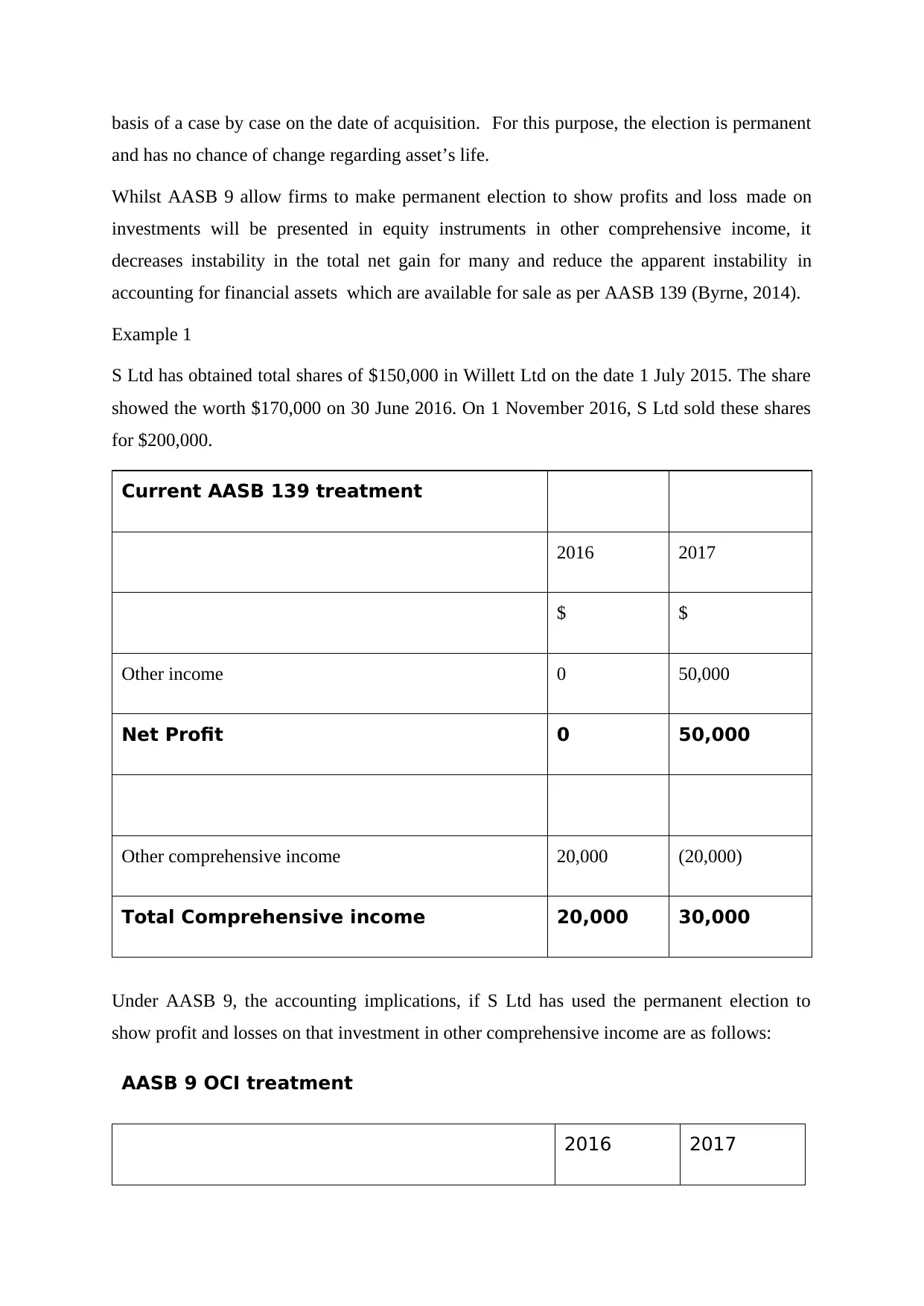
basis of a case by case on the date of acquisition. For this purpose, the election is permanent
and has no chance of change regarding asset’s life.
Whilst AASB 9 allow firms to make permanent election to show profits and loss made on
investments will be presented in equity instruments in other comprehensive income, it
decreases instability in the total net gain for many and reduce the apparent instability in
accounting for financial assets which are available for sale as per AASB 139 (Byrne, 2014).
Example 1
S Ltd has obtained total shares of $150,000 in Willett Ltd on the date 1 July 2015. The share
showed the worth $170,000 on 30 June 2016. On 1 November 2016, S Ltd sold these shares
for $200,000.
Current AASB 139 treatment
2016 2017
$ $
Other income 0 50,000
Net Profit 0 50,000
Other comprehensive income 20,000 (20,000)
Total Comprehensive income 20,000 30,000
Under AASB 9, the accounting implications, if S Ltd has used the permanent election to
show profit and losses on that investment in other comprehensive income are as follows:
AASB 9 OCI treatment
2016 2017
and has no chance of change regarding asset’s life.
Whilst AASB 9 allow firms to make permanent election to show profits and loss made on
investments will be presented in equity instruments in other comprehensive income, it
decreases instability in the total net gain for many and reduce the apparent instability in
accounting for financial assets which are available for sale as per AASB 139 (Byrne, 2014).
Example 1
S Ltd has obtained total shares of $150,000 in Willett Ltd on the date 1 July 2015. The share
showed the worth $170,000 on 30 June 2016. On 1 November 2016, S Ltd sold these shares
for $200,000.
Current AASB 139 treatment
2016 2017
$ $
Other income 0 50,000
Net Profit 0 50,000
Other comprehensive income 20,000 (20,000)
Total Comprehensive income 20,000 30,000
Under AASB 9, the accounting implications, if S Ltd has used the permanent election to
show profit and losses on that investment in other comprehensive income are as follows:
AASB 9 OCI treatment
2016 2017
⊘ This is a preview!⊘
Do you want full access?
Subscribe today to unlock all pages.

Trusted by 1+ million students worldwide
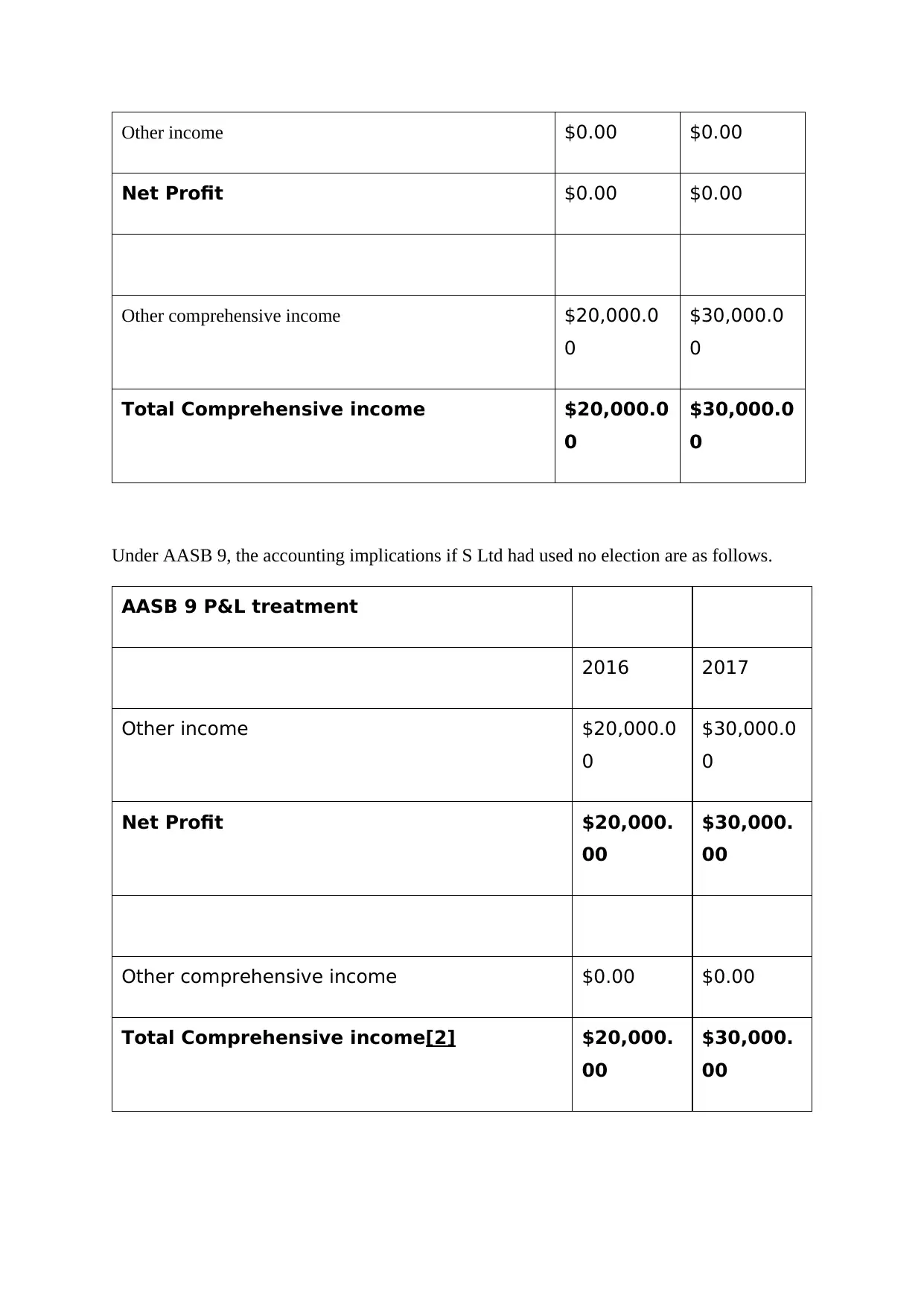
Other income $0.00 $0.00
Net Profit $0.00 $0.00
Other comprehensive income $20,000.0
0
$30,000.0
0
Total Comprehensive income $20,000.0
0
$30,000.0
0
Under AASB 9, the accounting implications if S Ltd had used no election are as follows.
AASB 9 P&L treatment
2016 2017
Other income $20,000.0
0
$30,000.0
0
Net Profit $20,000.
00
$30,000.
00
Other comprehensive income $0.00 $0.00
Total Comprehensive income[2] $20,000.
00
$30,000.
00
Net Profit $0.00 $0.00
Other comprehensive income $20,000.0
0
$30,000.0
0
Total Comprehensive income $20,000.0
0
$30,000.0
0
Under AASB 9, the accounting implications if S Ltd had used no election are as follows.
AASB 9 P&L treatment
2016 2017
Other income $20,000.0
0
$30,000.0
0
Net Profit $20,000.
00
$30,000.
00
Other comprehensive income $0.00 $0.00
Total Comprehensive income[2] $20,000.
00
$30,000.
00
Paraphrase This Document
Need a fresh take? Get an instant paraphrase of this document with our AI Paraphraser
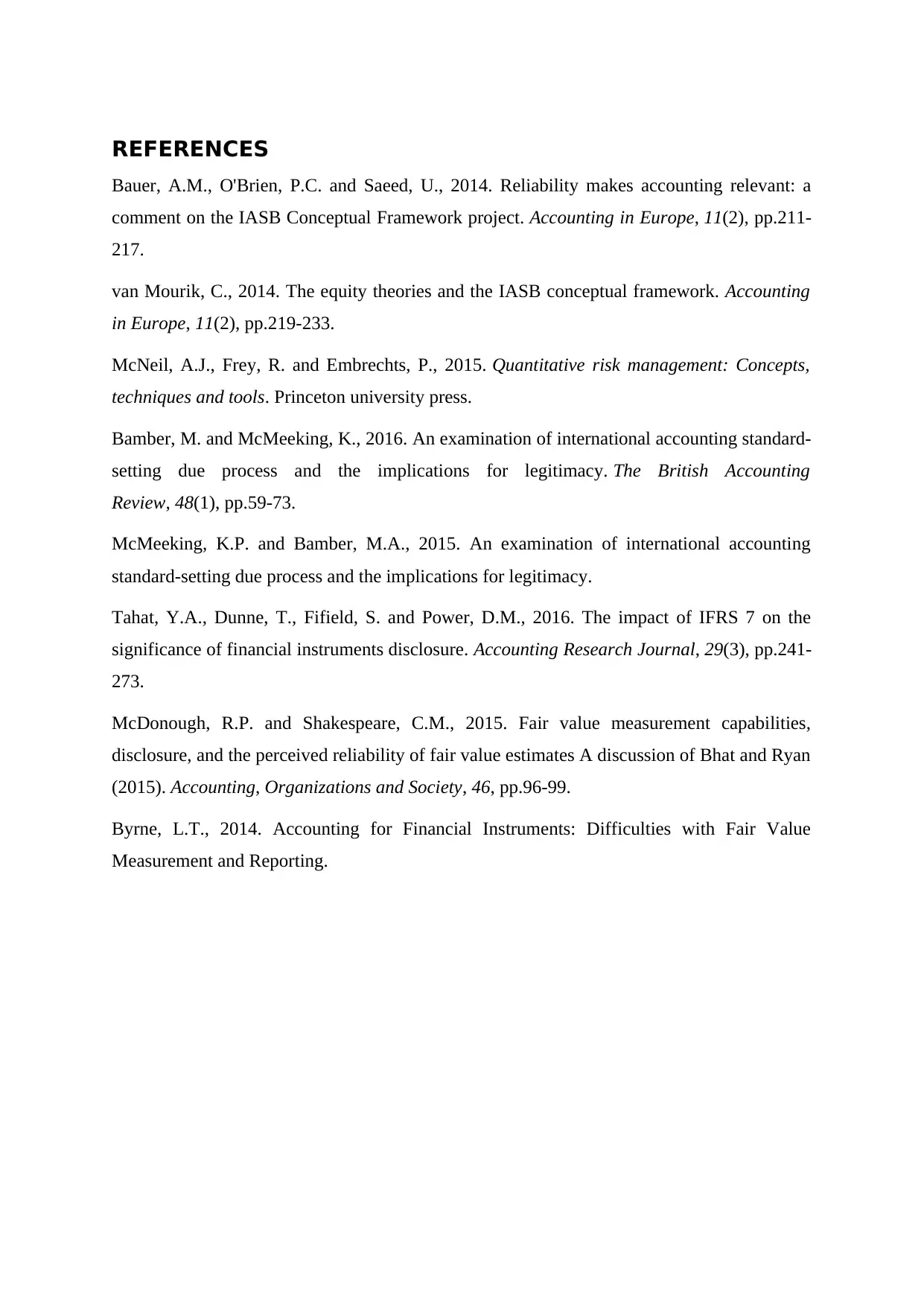
REFERENCES
Bauer, A.M., O'Brien, P.C. and Saeed, U., 2014. Reliability makes accounting relevant: a
comment on the IASB Conceptual Framework project. Accounting in Europe, 11(2), pp.211-
217.
van Mourik, C., 2014. The equity theories and the IASB conceptual framework. Accounting
in Europe, 11(2), pp.219-233.
McNeil, A.J., Frey, R. and Embrechts, P., 2015. Quantitative risk management: Concepts,
techniques and tools. Princeton university press.
Bamber, M. and McMeeking, K., 2016. An examination of international accounting standard-
setting due process and the implications for legitimacy. The British Accounting
Review, 48(1), pp.59-73.
McMeeking, K.P. and Bamber, M.A., 2015. An examination of international accounting
standard-setting due process and the implications for legitimacy.
Tahat, Y.A., Dunne, T., Fifield, S. and Power, D.M., 2016. The impact of IFRS 7 on the
significance of financial instruments disclosure. Accounting Research Journal, 29(3), pp.241-
273.
McDonough, R.P. and Shakespeare, C.M., 2015. Fair value measurement capabilities,
disclosure, and the perceived reliability of fair value estimates A discussion of Bhat and Ryan
(2015). Accounting, Organizations and Society, 46, pp.96-99.
Byrne, L.T., 2014. Accounting for Financial Instruments: Difficulties with Fair Value
Measurement and Reporting.
Bauer, A.M., O'Brien, P.C. and Saeed, U., 2014. Reliability makes accounting relevant: a
comment on the IASB Conceptual Framework project. Accounting in Europe, 11(2), pp.211-
217.
van Mourik, C., 2014. The equity theories and the IASB conceptual framework. Accounting
in Europe, 11(2), pp.219-233.
McNeil, A.J., Frey, R. and Embrechts, P., 2015. Quantitative risk management: Concepts,
techniques and tools. Princeton university press.
Bamber, M. and McMeeking, K., 2016. An examination of international accounting standard-
setting due process and the implications for legitimacy. The British Accounting
Review, 48(1), pp.59-73.
McMeeking, K.P. and Bamber, M.A., 2015. An examination of international accounting
standard-setting due process and the implications for legitimacy.
Tahat, Y.A., Dunne, T., Fifield, S. and Power, D.M., 2016. The impact of IFRS 7 on the
significance of financial instruments disclosure. Accounting Research Journal, 29(3), pp.241-
273.
McDonough, R.P. and Shakespeare, C.M., 2015. Fair value measurement capabilities,
disclosure, and the perceived reliability of fair value estimates A discussion of Bhat and Ryan
(2015). Accounting, Organizations and Society, 46, pp.96-99.
Byrne, L.T., 2014. Accounting for Financial Instruments: Difficulties with Fair Value
Measurement and Reporting.

⊘ This is a preview!⊘
Do you want full access?
Subscribe today to unlock all pages.

Trusted by 1+ million students worldwide
1 out of 9
Related Documents
Your All-in-One AI-Powered Toolkit for Academic Success.
+13062052269
info@desklib.com
Available 24*7 on WhatsApp / Email
![[object Object]](/_next/static/media/star-bottom.7253800d.svg)
Unlock your academic potential
Copyright © 2020–2025 A2Z Services. All Rights Reserved. Developed and managed by ZUCOL.





